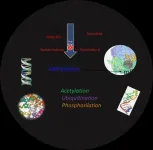(Press-News.org) The kangaskhan, Australia's only species of endemic Pokemon in Pokemon Go, is commonly poached within its natural habitat by Pokemon trainers for use in fighting contests
Researchers used several species distribution modeling algorithms to predict how climate change, on top of the already existing human-induced pressures, would impact the distribution of the kangaskhan in the future
In addition to this, they found a way to measure how biased commonly used species distribution models are, and found that some models are so biased that their results weren't influenced by the data at all
The researchers compared these results to previously published models for hundreds of species of Australian mammals and found similar biases
This research has highlighted specific problems with common species distribution models, and has given scientists new statistical tools to refine them in the future
Kangaskhan (Garura kangaskhani) are two-meter-tall Pokemon, endemic to Australia. Although commonly spotted around cities and other urban areas, information is lacking about their basic biology and wider range distribution. Much of what is known is based on anecdotes from the public, especially unlicensed breeders, many of whom are not trained in scientific research. Today, kangaskhan are believed to be threatened due to frequent poaching of adults and eggs. The poaching is primarily motivated by the demand for these animals to be used in fighting contests. This pressure, combined with the fact that climate change is predicted to have a large impact in Australia over the next few decades, has resulted in a bleak outlook for this majestic Pokemon species.
Now, researchers in the Biodiversity and Biocomplexity Unit at the Okinawa Institute of Science and Technology Graduate University (OIST) have taken an extensive look at how climate change will impact the existence of suitable habitat for kangaskhan. This study was published today in Methods in Ecology and Evolution.
"Apart from seeming to prefer partly cloudy weather, very little is known about the species' climatic preferences," said lead author Dr. Dan Warren, who previously worked as a researcher in Australia. "This makes it difficult to estimate the response of kangaskhan to environmental change, or how climate change might combine with the effects of poaching to impact the species' long-term survival. For this research, we used several well-known modeling methods to gain insight into how threatened kangaskhan really are."
With data that was initially recorded by hobbyists and professional trainers seeking out kangaskhan for exploitation, the researchers attempted to shed light on what the future holds for this species. Species distribution models were the obvious way to go. These models are a common way for scientists to predict changes in the availability of suitable habitat for a species, in response to estimated shifts in environmental parameters like rainfall, humidity, temperature, and vegetation cover.
In terms of the results, the models differed on what they predicted the future to be for the kangaskhan depending on the algorithms used. Three of the models predicted a decrease in habitat suitability, though differed substantially on the magnitude of this decline. Two other models switched their answer depending on the climate estimates used, and a sixth model predicted an increase in suitability of habitat. Policymakers and stakeholders should take this uncertainty into account and err on the side of caution when it comes to safeguarding the future of kangaskhan.
Aside from revealing uncertainty surrounding the long-term survival of kangaskhan, the research has also shed light on how scientists can calculate the biases that come with species distribution models. Every one of these models comes with a level of bias and uncertainty, depending on the choices made in the modeling process. For example, when predicting the implications of climate change, the amount of future CO2 emissions needs to be considered, and yet estimating this can be tricky as it's based on human behavior. Differences in these estimates can interact with other aspects of the modeling process, resulting in biases in predictions of how climate change will affect threatened and endangered species. Scientists know about these biases but have never found a way to measure them before, until now.
"We found that we could determine the level of bias with a simple statistical test," said Dr. Warren. "And, in doing so, we realized that some of these models could be so biased that the data didn't have much effect on their results... effectively the conclusion was picked based on study design regardless of what the data actually showed," said Dr. Warren.
In addition to the kangaskhan, the researchers demonstrated similar biases for these models by reexamining a previous study that built models for 220 species of Australian mammals, as well as a study that simulated artificial organisms in order to understand how well models estimated species' environmental tolerances. The researchers hope that by revealing these biases they are providing a more secure future for kangaskhan and the rest of the world's biodiversity.
Dr. Warren emphasized that although the study itself might seem strange, what it's revealed will actually go on to help other researchers create more robust estimates of species distribution. His primary reason for choosing to do this research on a Pokemon character was to engage a broader audience with issues that conservation scientists regularly need to think about.
"It's a bit silly but it's also cool science," said Dr. Warren. "Stakeholders use these models for predicting a number of important ecological phenomena, from the effects of climate change, to the dispersal of diseases and invasive species, so having a firm understanding of the biases the models might have is important. We've just scratched the surface of what we can do with this method so I think this could be a useful tool for a whole bunch of things."
His final point was a word of caution with respect to the culture that surrounds Pokemon. "It's specifically based around over-exploitation with the tagline 'gotta catch them all.' The rarer they get, the more valuable they get. This is like some of the larger tuna species, which are in serious danger of going extinct. We might have focused on climate change in this study but, for many Pokemon (and many species around the world), overexploitation should also be a concern."
INFORMATION:
Obesity rates have increased dramatically in developed countries over the past 40 years -- and many people have assumed that food marketing is at least in part to blame. But are people with obesity really more susceptible to food marketing? And if they are, is that a permanent predisposition, or can it change over time?
According to a new study by UBC Sauder School of Business Assistant Professor Dr. Yann Cornil (he/him/his) and French researchers, people with obesity do tend to be more responsive to food marketing -- but when their weight drops significantly, so does their responsiveness to marketing.
For the study, which was published in the Journal of Consumer Psychology, the researchers followed three groups: patients with severe ...
Oak Brook, IL - The April edition of SLAS Discovery is a special issue on advances in protein degradation curated by guest editors M. Paola Castaldi, Ph.D., and Stewart L. Fisher, Ph.D.
Targeted protein degradation has generated interest within the drug discovery arena due to the inhibition of one particular function of a protein not often delivering the successful results that comes from whole-protein depletion. The pharmacology of PROTACs present challenges, however, namely for the development of orally bioavailable drugs. In the article "Target Validation Using PROTACs: Applying the Four Pillars Framework" authors Rados?aw P. Nowak, Ph.D., and Lyn H. Jones, Ph.D., describe the application of a translational pharmacology framework (the four pillars) ...
Oak Brook, IL - The April edition of SLAS Technology features the cover article "Therapeutic Potential of Reactive Oxygen Species: State of the Art and Recent Advances" by Valeria Graceffa, Ph.D. (Institute of Technology Sligo, Sligo, Ireland).
The cover article explores the therapeutic potential of reactive oxygen species (ROS) including applications ranging from wound healing and hair growth enhancement, to cancer treatment, stem cell differentiation and tissue engineering. At low concentrations, ROS can be utilized as inexpensive and convenient inducers of tissue regeneration, triggering stem cell differentiation and enhancing collagen synthesis. Recent cancer studies have represented ROS as the 'Achilles Heels' of cancers given their high basal levels, leaving ...
(APRIL 1, 2021) -The pandemic has exacerbated risk factors for gender-based violence, such as unemployment and financial strain, substance use, isolation, depression anxiety, and general stress, according to the American Psychological Association. That's inspired The University of Texas at San Antonio criminology and criminal justice professor Kellie Lynch, along with professor TK Logan from the University of Kentucky, to work with the National Coalition Against Domestic Violence on a national survey to investigate the impact of the COVID-19 pandemic on the dynamics of gender-based violence and the experiences of those serving victims of gender-based violence.
"The consequences of the COVID-19 pandemic are far-reaching and we still have much to learn about ...
The public could lose trust in science if scientific and medical researchers choose to bypass the traditional high standards of peer-reviewed medical journals in the rush to get research data released, particularly during crises such as the COVID-19 pandemic.
That's the warning from three leading medical communications organizations, that have published a joint statement in the peer-reviewed journal Current Medical Research and Opinion - asserting that the integrity of published scientific and medical research must be protected.
Out today, the joint statement from the American Medical ...
Review of 40 published studies from 17 countries offers first global assessment of the collateral impact of the COVID-19 pandemic on pregnancy outcomes.
Findings reveal overall increase in the chances of stillbirth and maternal death during the pandemic, but chances of pre-term birth decreased in high-income countries.
Women requiring surgery for ectopic pregnancies increased almost six-fold during the pandemic across all studies, after accounting for the size of included studies (surgery rate for ectopic pregnancies during pandemic 27/37 vs pre-pandemic 73/272), and symptoms of maternal depression were also increased.
Study reveals disproportionate impact ...
The pandemic is affecting every country, but not every country has equal access to the lifesaving COVID-19 vaccines. Recent estimates show that high-income countries -- which have just one-fifth of the global adult population -- have purchased more than half of the world's total vaccine doses, resulting in disparities for low- and middle-income countries.
A new study by researchers at Virginia Commonwealth University investigates a key question: Will the U.S. population support donating part of its COVID-19 vaccine stockpile to less prosperous countries?
"COVID-19 is a true global pandemic that has touched every nation ...
Houston Methodist has been a leader in successfully treating high-risk patients with monoclonal antibodies (mAB) for mild to moderate Covid-19 infection. Among the nation's largest providers of mAB therapy, Houston Methodist has infused nearly 4,000 patients since the FDA's Emergency Use Authorization (EUA) was issued. The hospital system was able to quickly ramp up its program once the EUA was granted by leveraging a number of resources through interdisciplinary collaboration.
As more hospitals begin to ramp up for treating Covid-19 with mAB therapy, Houston Methodist's example serves as a valuable model for other medical systems to establish or expand mAB treatment programs and improve patient access to this critical therapy. A commentary outlining the challenges, ...
A team of University of Colorado School of Medicine researchers recently published a paper offering new insight into the role that oxygen deprivation, or hypoxia, plays in cancer development. CU Cancer Center member Joaquin Espinosa, PhD, is the senior researcher on the paper, which he hopes will help lead to more targeted treatments for cancer.
For their paper published this month in the journal Nature Communications, Espinosa and the rest of the team -- Zdenek Andrysik, PhD; Heather Bender, PhD; and Matthew Galbraith, PhD -- used state-of-the-art genomics technologies to map the response of cancer cells to hypoxia with unprecedented detail, ...
Abusive alcohol drinking considerably impacts human health. Alcoholism, better defined as Alcohol Use Disorders (AUD), includes a group of pathological entities related to alcohol-induced damage. Individuals with AUD exhibit compulsive alcohol drinking and negative emotional states when alcohol drinking ceases. In the most severe AUD forms, the individuals lose control over consumption despite a decided will to stop. Some controversial issues have arisen as to whether the definition of AUD can help to delimit and characterize clinical entities related to abusive alcohol ingestion.
The World Health Organization (WHO) reports that approximately 3,3 million people (5,9% of global ...


